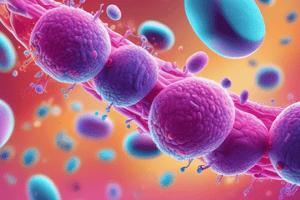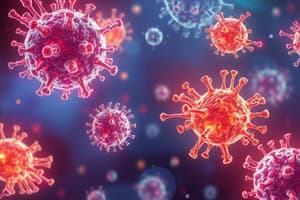Podcast
Questions and Answers
What is the primary reason for antimicrobial drug resistance?
What is the primary reason for antimicrobial drug resistance?
- Use and inappropriate use of antimicrobial agents (correct)
- Environmental changes
- Natural evolution of bacteria
- Mutation of viruses
Which of the following is included in the category of antimicrobial agents?
Which of the following is included in the category of antimicrobial agents?
- Vitamins
- Minerals
- Antiseptics (correct)
- Proteins
What is the role of β-lactams in bacterial cell wall biosynthesis?
What is the role of β-lactams in bacterial cell wall biosynthesis?
- Transport of lipid-bound precursors
- Directly causing cell lysis
- Inhibition of nucleic acid synthesis
- Forming covalent complexes with peptidoglycan synthesis enzymes (correct)
What is antibiotic stewardship primarily concerned with?
What is antibiotic stewardship primarily concerned with?
Which step is inhibited by D-Cycloserine in peptidoglycan biosynthesis?
Which step is inhibited by D-Cycloserine in peptidoglycan biosynthesis?
What structural element is critical for cross-linking in the peptidoglycan layer of bacterial cell walls?
What structural element is critical for cross-linking in the peptidoglycan layer of bacterial cell walls?
Which statement about gram-positive and gram-negative bacteria is true?
Which statement about gram-positive and gram-negative bacteria is true?
How does inappropriate use of antimicrobial agents lead to drug resistance?
How does inappropriate use of antimicrobial agents lead to drug resistance?
What is the function of glycopeptides like vancomycin in bacterial treatment?
What is the function of glycopeptides like vancomycin in bacterial treatment?
Which two key enzymes are involved in the inhibition of folate synthesis?
Which two key enzymes are involved in the inhibition of folate synthesis?
What is the primary mechanism of action of quinolones?
What is the primary mechanism of action of quinolones?
Which antimicrobial is primarily used in combination to treat Mycobacterium tuberculosis?
Which antimicrobial is primarily used in combination to treat Mycobacterium tuberculosis?
What defines intrinsic resistance in microorganisms?
What defines intrinsic resistance in microorganisms?
How do aminoglycosides affect bacterial cells?
How do aminoglycosides affect bacterial cells?
What characterizes tolerance in bacterial populations?
What characterizes tolerance in bacterial populations?
Which of the following statements about acquired resistance is true?
Which of the following statements about acquired resistance is true?
What is the primary purpose of antimicrobial susceptibility testing?
What is the primary purpose of antimicrobial susceptibility testing?
Which of the following factors is NOT crucial when determining the need for susceptibility testing?
Which of the following factors is NOT crucial when determining the need for susceptibility testing?
What is one function of β-lactamase inhibitors?
What is one function of β-lactamase inhibitors?
Which culture scenario is likely to indicate a true infection?
Which culture scenario is likely to indicate a true infection?
What is a characteristic of normal microbiota relevant to susceptibility testing?
What is a characteristic of normal microbiota relevant to susceptibility testing?
How many antimicrobial agents should be routinely tested against certain bacterial groups?
How many antimicrobial agents should be routinely tested against certain bacterial groups?
What is the minimal inhibitory concentration (MIC) method used for?
What is the minimal inhibitory concentration (MIC) method used for?
What is a common method used for antimicrobial susceptibility testing?
What is a common method used for antimicrobial susceptibility testing?
Flashcards
Bacterial Cell Wall
Bacterial Cell Wall
A multilayered structure in bacteria composed of an inner cytoplasmic membrane, a peptidoglycan layer, and an outer membrane (in gram-negative bacteria).
Peptidoglycan
Peptidoglycan
A complex molecule found in bacterial cell walls, composed of alternating sugar molecules (NAG, NAM) linked by peptide chains.
Peptidoglycan Biosynthesis
Peptidoglycan Biosynthesis
The process of building the bacterial cell wall, involving multiple steps including synthesis of precursors, transport across membranes, insertion of glycan, and cross-linking.
β-lactams
β-lactams
Signup and view all the flashcards
D-alanyl-D-alanine (D-Ala-D-Ala)
D-alanyl-D-alanine (D-Ala-D-Ala)
Signup and view all the flashcards
D-Cycloserine
D-Cycloserine
Signup and view all the flashcards
Bacitracin
Bacitracin
Signup and view all the flashcards
Transpeptidation
Transpeptidation
Signup and view all the flashcards
β-Lactamase Inhibitors
β-Lactamase Inhibitors
Signup and view all the flashcards
Antimicrobial Susceptibility Testing
Antimicrobial Susceptibility Testing
Signup and view all the flashcards
Disk Diffusion
Disk Diffusion
Signup and view all the flashcards
Dilution (MIC)
Dilution (MIC)
Signup and view all the flashcards
Body Site
Body Site
Signup and view all the flashcards
Presence of Other Bacteria & Quality of Specimen
Presence of Other Bacteria & Quality of Specimen
Signup and view all the flashcards
Host Status
Host Status
Signup and view all the flashcards
Selection of Test Batteries
Selection of Test Batteries
Signup and view all the flashcards
Penicillins
Penicillins
Signup and view all the flashcards
Glycopeptides
Glycopeptides
Signup and view all the flashcards
Folate Synthesis
Folate Synthesis
Signup and view all the flashcards
Quinolones
Quinolones
Signup and view all the flashcards
Rifampin
Rifampin
Signup and view all the flashcards
Tolerance
Tolerance
Signup and view all the flashcards
Intrinsic Resistance
Intrinsic Resistance
Signup and view all the flashcards
Acquired Resistance
Acquired Resistance
Signup and view all the flashcards
Study Notes
Antimicrobial Mechanisms of Action and Bacterial Resistance Mechanisms
- Antibacterial mechanisms of action include targeting bacterial cell wall biosynthesis, folate synthesis, DNA replication, DNA transcription, and mRNA translation.
- Antimicrobial agents, including antibacterials, antifungals, antiseptics, antibiotics, preservatives, sterilants, and disinfectants, all have the capacity to kill or suppress microbial growth.
- Bacterial resistance mechanisms include acquired resistance, biofilm formation, enzymatic inactivation, efflux, and target site modification.
- Antimicrobial drug resistance was observed soon after the discovery of antibiotics.
- The World Health Organization estimates at least 10 million deaths per year by 2050, due to infections caused by drug-resistant bacteria.
- Antibiotic stewardship is the appropriate use of antimicrobials to maximize their current effects and ensure their availability for future generations.
Antimicrobial Agents
- Antimicrobials include antibacterials, antifungals, antiseptics, antibiotics, preservatives, sterilants, and disinfectants.
Antimicrobial Drug Resistance
- Resistance is a natural consequence of drug exposure from the use and inappropriate use of antimicrobial agents.
- It is observed soon after the discovery of antibiotics.
Antibiotic Stewardship
- Refers to the appropriate use of antimicrobials to maximize their current effects and improve the chances of their being available for future generations.
Antimicrobial Targets and Mechanisms of Action
- Inhibition of Bacterial Cell Wall Biosynthesis
- Inhibition of Folate Synthesis
- Interference with DNA Replication
- Interference with DNA Transcription
- Interference of mRNA Translation
Inhibition of Bacterial Cell Wall Biosynthesis
- Gram-positive and gram-negative bacteria have a multilayered cell wall structure composed of an inner cytoplasmic membrane, a peptidoglycan layer, and in gram-negative bacteria, an outer membrane.
Inhibition of Bacterial Cell Wall Biosynthesis- Peptidoglycan Structure
- Peptidoglycan structure consists of alternating disaccharides (NAG, NAM) with peptide cross-links.
- The peptide consists of L- and D-amino acids, typically ending in D-alanyl-D-alanine (D-Ala-D-Ala).
- The D-Ala-D-Ala sequence is critical for cross-linking and drug targeting.
Inhibition of Bacterial Cell Wall Biosynthesis Stages
- Synthesis of precursors in the cytoplasm
- Transport of lipid-bound precursors across the cytoplasmic membrane
- Insertion of glycan units into the cell wall
- Transpeptidation linking and maturation.
- D-Cycloserine and bacitracin inhibit the first two steps, respectively.
Most Commonly Used Inhibitors of Cell Wall Biosynthesis
- β-lactams (e.g., penicillin and cephalosporins) act by forming covalent complexes with enzymes that generate the mature peptidoglycan molecule and bind PBPs (penicillin binding proteins). They inhibit cross-linking and can cause lysis.
- Glycopeptides (e.g., vancomycin, dalbavancin, teicoplanin) bind D-Ala-D-Ala, block transpeptidation, and are effective for Gram-positives.
Inhibition of Folate Synthesis
- Mediated by two key enzymes: dihydropteroate synthase and dihydrofolate reductase.
- These enzymes mediate the formation of tetrahydrofolate (THF) from dihydrofolate.
- Examples include Sulfamethoxazole (SMZ) and Trimethoprim (TMP)
Interference with DNA Replication
- Quinolones affect DNA replication by targeting topoisomerases II (DNA gyrase) and IV.
- These enzymes are important in controlling DNA topology, replication, and decatenation at the end of the bacterial DNA replicative cycle.
Interference with DNA Transcription
- Rifampin is used in combination with other antibacterial classes to treat Mycobacterium tuberculosis infection.
- The target in M. tuberculosis is the RNA polymerase β subunit at an allosteric site, blocking RNA chain elongation.
- This aborts RNA transcription at the initiation step.
Interference of mRNA Translation
- Aminoglycosides, tetracyclines, macrolides (erythromycin, clarithromycin, and azithromycin), ketolides, oxazolidinones, glycylcyclines, and streptogramins interfere with mRNA translation.
Antimicrobial Susceptibility Testing
- Performed on bacteria and fungi to determine which antimicrobials are effective.
- Methods include disk diffusion and dilution (minimal inhibitory concentration [MIC]).
Factors to Consider When Determining Whether Testing Is Warranted
- Body site from which the bacterium was isolated
- Presence of other organisms and quality of the specimen from which the organism was grown
- Host's status
Body Site
- Normal microbiota: E. coli (lower GI), viridans group streptococci (throat), coagulase-negative staphylococci (wound), yeasts (vaginal specimens or throat)
Presence of Other Bacteria and Quality of Specimen
- A pure culture of a bacterium (e.g., E. coli, above 10^5 CFU/mL) is more likely to represent a true infection and should be tested. A few K. pneumoniae organisms in the presence of other organisms in a specimen (like oropharyngeal flora in sputum) might not be significant.
Host Status
- Species usually viewed as normal microbiota might be responsible for an infection in immunocompromised patients and may therefore require testing.
Selecting Antimicrobial Agents for Testing and Reporting
- 10 to 15 antimicrobial agents are typically tested routinely against Enterobacteriaceae, Pseudomonas spp., nonfastidious gram-negative bacilli (e.g., Acinetobacter spp., Stenotrophomonas maltophilia, and Burkholderia cepacia), staphylococci, and enterococci.
Reporting of Susceptibility Test Results
- Results are reported showing susceptibility (S) or resistance (R) for each tested drug.
- Tables are used to present these results, group microorganisms based on specific antibiotics and interpret results properly.
Traditional Antimicrobial Susceptibility Test Methods
- Methods, like the Kirby-Bauer test, are used in traditional susceptibility tests to measure the effectiveness of antibiotics by observing zones of inhibition.
Studying That Suits You
Use AI to generate personalized quizzes and flashcards to suit your learning preferences.





